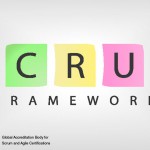There is a common misconception that the Scrum framework can only be used for small projects. However, it can easily be scaled for effective use in large projects. Large or complex projects are often implemented as part of a program or portfolio. The Scrum framework can easily be applied to manage even programs and portfolios. The logical approach of the guidelines and principles in this framework can be used to manage projects of any size, spanning geographies and organizations. Large projects may have multiple Scrum Teams working in parallel making it necessary to synchronize and facilitate the flow of information and enhance communication. The Convene Scrum of Scrums is the process ensuring this synchronization. The various Scrum Teams are represented in this meeting and the objectives are to provide updates about progress, discuss challenges faced during the project, and coordinate activities. There are no set rules regarding the frequency of these meetings. The factors determining the frequency are the amount of inter-team dependency, size of the project, Scrum Guidance Body recommendations and the level of complexity.
In programs, important roles to manage Scrum programs are:
1. Program Product Owner—Defines the strategic objectives and priorities for the program
2. Program Scrum Master—Solves problems, removes impediments, facilitates, and conducts meetings for the program
These roles are similar to those of the Product Owner and Scrum Master, except that they meet the needs of their program or business unit rather than those of a single Scrum Team.
Similarly, in portfolios, important roles to manage Scrum portfolios are:
1. Portfolio Product Owner—Defines the strategic objectives and priorities for the portfolio
2. Portfolio Scrum Master—Solves problems, removes impediments, facilitates, and conducts meetings for the portfolio
The needs and structure of each organization are different. It is the responsibility of the Scrum Guidance Body to scrutinize the organization at different levels to understand and define appropriate application of Scrum and to act as a consulting body for everyone working on a project, program, or portfolio.
When applying Scrum to manage projects within the context of a program or portfolio, it is strongly recommended that the general principles of Scrum presented in the SBOK™ are adhered to. It is understood, though, that in order to accommodate the overall program or portfolio activities and interdependencies, minor adjustments to the set of tools, as well as to the organizational structure may be required.
Portfolios and programs have separate teams with different sets of objectives. Program management teams aim to deliver capabilities and to realize certain goals that contribute toward the achievement of specific program objectives. In contrast, the portfolio team has to balance the objectives of various programs to achieve the strategic objectives of the organization as a whole.
The problems and issues faced when using Scrum within a program or portfolio primarily involve coordination across numerous teams. This can lead to failure if not carefully managed. Tools used for communication need to be scaled to match the requirements of the many teams involved in a program or portfolio. Each Scrum Team must address not only internal communications, but also external communications with other teams and the relevant stakeholders of the program or portfolio.
A Scrum of Scrums Meeting is an important element when scaling Scrum to large projects. Typically, there is one representative in the meeting from each Scrum Team—usually the Scrum Master—but it is also common for anyone from the Scrum Team to attend the meeting if required. This meeting is usually facilitated by the Chief Scrum Master and is intended to focus on areas of coordination and integration between the different Scrum Teams. This meeting is conducted at pre-determined intervals or when required by the Scrum Teams.
In organizations that have several Scrum projects happening simultaneously, the Scrum of Scrums meeting can be scaled up another level to what is referred to as a Scrum of Scrum of Scrums meeting. In this situation, a separate Scrum of Scrums Meeting is held to coordinate each group of projects that are directly related to each other.
Source: Scrum Body of Knowledge (SBOKTM Guide – 2013 Edition)









